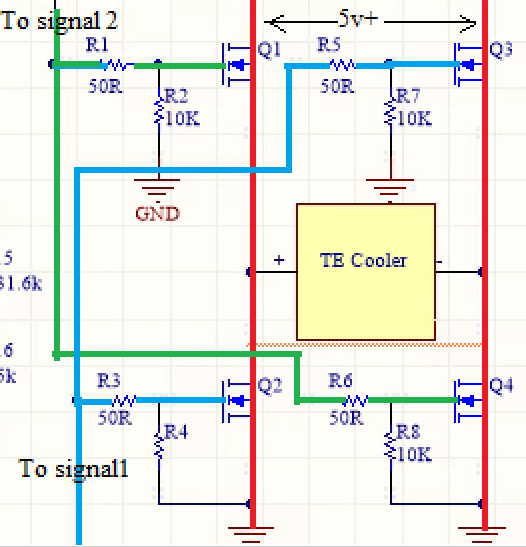There is quite a lot of progress that has happened since my last post, but I’m going to start with the most significant breakthrough I had. I found the source of all my problems and it stemmed from my lack of understanding of the difference between N-channel and P-channel MOSFETs. I understood that P-channel MOSFETs were used to switch HIGH side voltages, but I did not understand that the logic was the inverse to N-ch MOSFETs! What this means is that I did not know that in order to close P-ch MOSFETs, you need to pull the Gate voltage LOW. I’ve used N-ch MOSFETs in my day so, intuitively, I thought P-ch was turned on the same way as N-ch; pull the Gate HIGH. Boy, was I wrong. So now onto what this means for my application. I have the gates of my N-ch and P-ch MOSFETs connected (HeatPulse and ColdPulse) so when HeatPulse is set to HIGH, there is a direct short to GND because the other P-ch remains closed since the gate is being pulled LOW by a pulldown resistor. This is shown below
There are a few solutions to this. One would be to implement an inverter between the MCU and the P-ch MOSFETs to invert the signal. The better solution I see though to purchase an H-bridge IC. This would eliminate many problems.
I also tested the thermoelectric module at different Power values to see how pronounced the temperature differential was. It turns ou that @3.8v and 800ma, the temp gradient is more than substantial for this application. This means I can remove the voltage boosting circuitry for the next iteration of the PCB. Currently, I have bridged the batttery voltage directly to the source of the transistors.
Next Week’s Work
For the symposium, I plan to just present the cooling feature with the voltage supplied either from a transformer connected to a wall outlet or the Lithium Ion battery. I need to remove the P-channel transistor and connected the voltage input of the thermoelectric module directly to Vsource. I need to consolidate the PCB, TE Module, heatsink, wrist strap, and battery into a single unit. Then I’ll play around with timing to get the optimal frequency of sending pulses.

